The history of soccer is filled with fascinating stories of football clubs that have been around for centuries. The oldest football club in the world, Sheffield FC, was founded in 1857. This marked the beginning of organized football. Many historic teams were established in this era, with 19 clubs founded in 1862 alone.
These clubs, like Sheffield FC, Nottingham Forest, and Queens Park, have shaped the beautiful game. Their founding years span from 1857 to 1918, showing 61 years of growth. The early 20th century saw clubs like Real Madrid CF and Leeds United FC, expanding the sport’s global reach. These oldest clubs have greatly enriched soccer history.

Key Takeaways
- The oldest football club in the world, Sheffield FC, was founded in 1857.
- 19 clubs were established in 1862, marking a significant year in soccer history.
- The founding years of historic football clubs range from 1857 to 1918.
- Notable teams like Everton FC and Manchester United FC were founded in 1878.
- The soccer history of these clubs is a testament to the enduring legacy of the sport.
- Football clubs have been instrumental in shaping the beautiful game, with many active today.
- The oldest clubs have contributed to the rich soccer history we enjoy today.
The Birth of Organized Football: Early 19th Century Origins
The early 19th century saw a big change in sports. Folk games turned into a structured sport called football. British public schools were key in making this happen. They worked on the game’s rules.
The first football match was recorded in England around 1170. But it was the 19th century that really shaped the game.
British public schools like Rugby and Cambridge were very important. They made their own rules. This led to a standard set of rules for football.
The first official rules were made at Rugby School in 1845. The Cambridge Rules, created in 1848, were another step towards standardization.
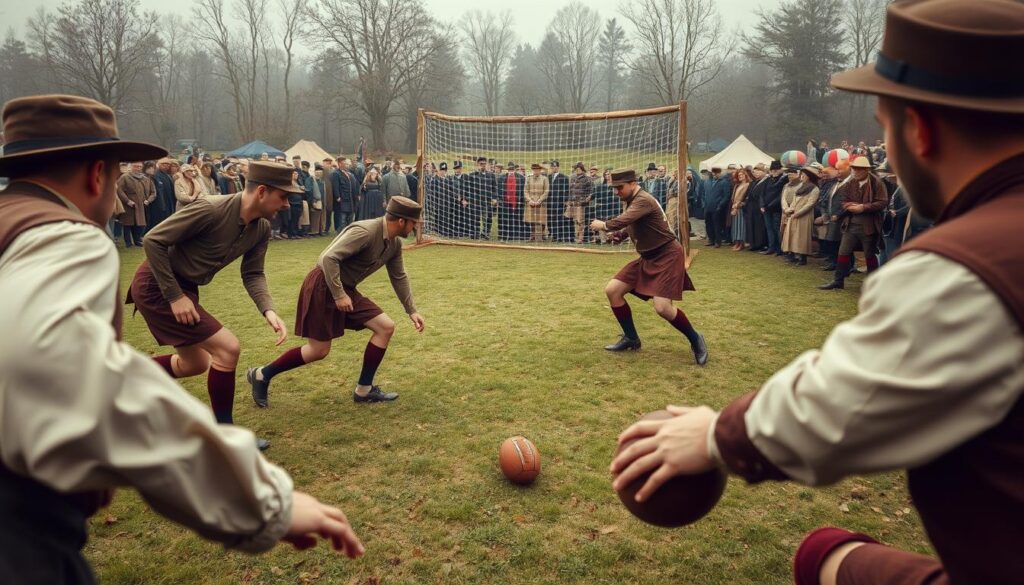
Rules evolved slowly, with schools and teams adding their ideas. The Football Association, started in 1863, was key in making rules the same for everyone. The early 19th century was a big time for football. Schools and teams helped make the game what it is today.
| Year | Event | Location |
|---|---|---|
| 1845 | First published rules for football | Rugby School |
| 1848 | Cambridge Rules created | Cambridge University |
| 1863 | Formation of the Football Association | London, England |
Sheffield FC: The World’s First Football Club
Sheffield FC, the oldest football club recognized by FIFA, was founded in 1857. This club played a big role in shaping the sport. Its early rules and regulations helped shape modern football.
The club’s founding started organized football. It introduced key elements like heading the ball and free kicks. These elements are now part of the game.
The Rulebook of 1859 became the basis for modern football laws. Sheffield FC’s influence goes beyond its own history. Its rules helped merge regional and London rules in 1878.
Today, Sheffield FC is a member of the Club of Pioneers. It has played in many historic matches, including the first-ever derby against Hallam FC.

As the first football club, Sheffield FC has a rich history. The club has played in many stadiums over the years. Its legacy inspires new fans and boosts the local economy.
Sheffield FC’s recognition by FIFA and its place in the Club of Pioneers make it key to football’s heritage. Its history is celebrated by fans worldwide.
Some notable achievements and facts about Sheffield FC include:
- Founded in 1857, making it the oldest football club in the world
- Recognized by FIFA as the oldest football club
- Member of the Club of Pioneers
- Participated in the first-ever derby match against Hallam FC
Understanding the Timeline of Historic Football Clubs
The history of football is long and full of twists. To grasp how the sport evolved, we must look at the football timeline. This timeline shows important events and milestones. It also sheds light on the role of historic clubs in shaping the game.
Early football was shaped by regional pioneers like Sheffield F.C. These clubs helped spread the sport. They fostered a sense of community and competition, fueling football’s growth. The football timeline also shows how historic clubsinfluenced the game, introducing new rules and regulations.
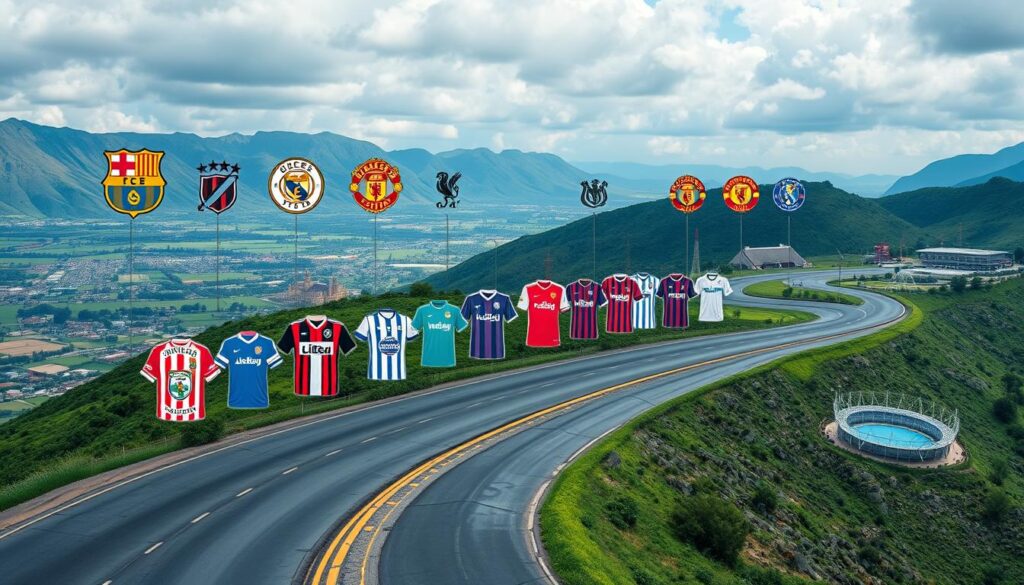
Key moments in the football timeline include the FA’s founding in 1863 and England’s first match against Scotland in 1872. The FA Cup’s start in 1871 was another major milestone. These events highlight the sport’s growth and the impact of regional pioneers.
| Year | Event | Description |
|---|---|---|
| 1863 | Founding of the FA | The Football Association was established, marking a significant milestone in the development of football. |
| 1871 | First FA Cup | The first FA Cup was held, with 15 teams participating in the competition. |
| 1872 | First international match | England and Scotland played the first international match, which ended in a 0-0 draw. |
The football timeline celebrates the sport’s rich history. It shows the contributions of historic clubs and regional pioneers. By studying this timeline, we can better understand football’s journey and its evolution over the years.
Cambridge University AFC: Academic Roots of the Beautiful Game
Cambridge University AFC has academic roots going back to 1856. It’s a key part of football history. The club says it’s the oldest football club in the world, but others like Sheffield FC disagree.
The academic roots of Cambridge University AFC are closely tied to the sport’s growth. In its early days, the club helped create the Cambridge Rules. These rules included the first off-side rule, changing the game forever.
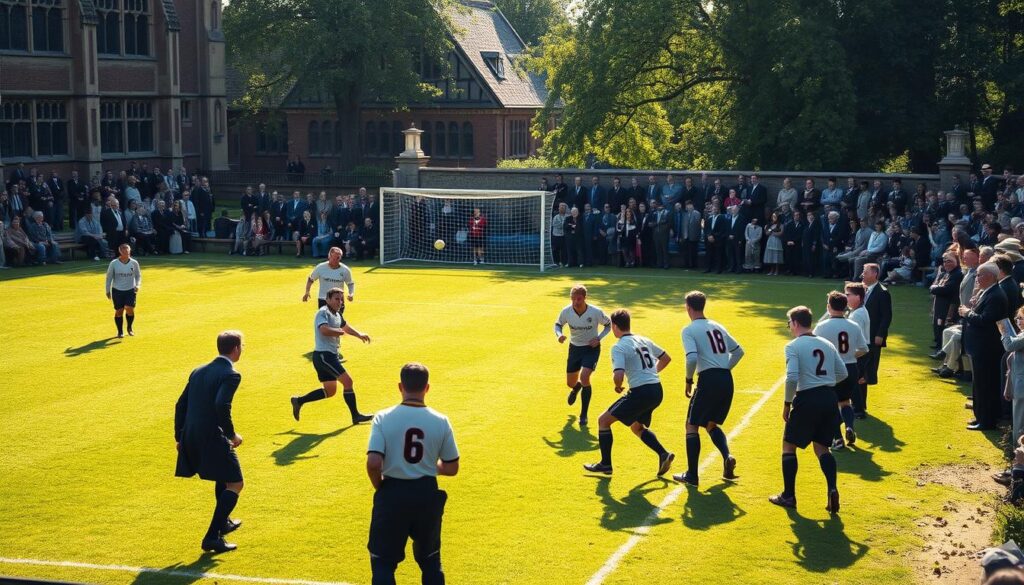
Cambridge University AFC shows its academic roots by balancing sports and studies. Last year, about 50% of its players got firsts in their studies. This shows the club’s dedication to both sports and learning.
The history of Cambridge University AFC is truly captivating. It shows how academic roots can influence a sport. The club’s rich history and traditions inspire many, making it a vital part of football today.
Hallam FC: The Second Oldest Club Stil Playing
Hallam FC was founded in 1860 and is the second oldest football club in the world. It plays at Sandygate Road, the oldest football stadium. For over 160 years, Hallam FC has been a key part of local football, playing in many local derbymatches.
The club’s home, Sandygate Road, can hold 1,350 fans and has hosted games for 160 years. Hallam FC is in the Northern Counties East League Premier Division, ranking fifth. Their long history shows their commitment to football heritage.
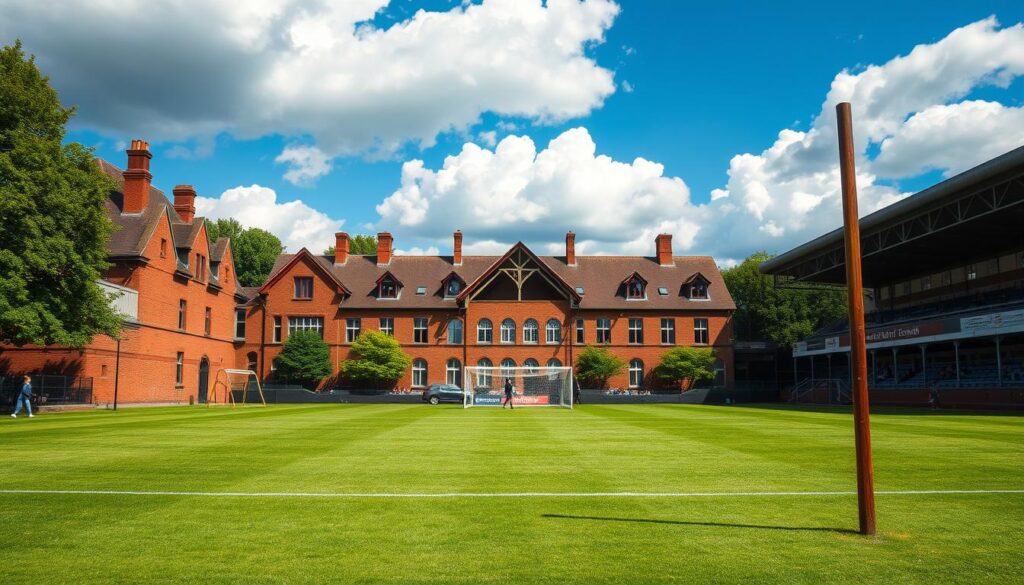
- Winning the Youdan Cup in 1867, which predates the FA Cup
- Introducing the crossbar to the game
- Being recognized as the second oldest club stil playing
Hallam FC is known for its local derby matches and preserving football heritage. As the second oldest club playing, it inspires football fans for generations.
Oldest Football Clubs in the World: A Complete Historical List
The history of football is rich and fascinating. The oldest football clubs have played a big role in shaping the sport. The historical list of these clubs shows the game’s lasting legacy. British pioneers like Sheffield FC, founded in 1857, helped create the football we know today.
British Pioneering Teams
Notable British pioneers include Notts County, founded in 1862, and Hallam FC, established in 1860. These clubs have a long history. Many are competing at a high level today.
Continental Europe’s First Clubs
While many oldest football clubs are from the UK, Continental Europe has its own. But, most of the oldest clubs are from the UK. The top 10 oldest football clubs are all from England, Scotland, or Wales.
| Club | Founding Year | Country |
|---|---|---|
| Sheffield FC | 1857 | England |
| Notts County | 1862 | England |
| Hallam FC | 1860 | England |
| Wrexham | 1864 | Wales |
| Nottingham Forest | 1865 | England |
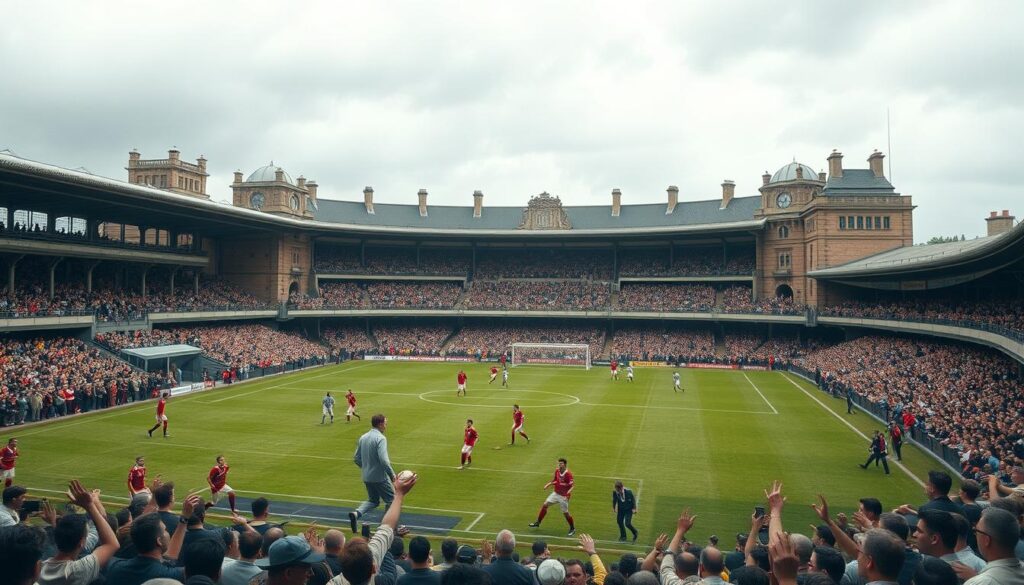
The Significance of Club Crests and Colors
Club crests and colors are key to a club’s identity and history. They show the club’s values and traditions. Many clubs have changed their crests and colors over time. These changes often mark important events or milestones.
Liverpool’s first badge, from 1892, had the Liver bird and maritime symbols. This showed the city’s success as a port. In 1989, the badge got eternal flames to honor the 96 victims of Hillsborough. Manchester United’s badge has changed too, adding the Red Devils nickname in the 1950s.
Arsenal’s badge has evolved from three cannons to one. Aston Villa’s badge features a Rampant Lion, a nod to its Scottish founders. Colors also hold deep meaning, often tied to a club’s history or location. Aston Villa’s claret and blue colors, for example, honor their Scottish roots.
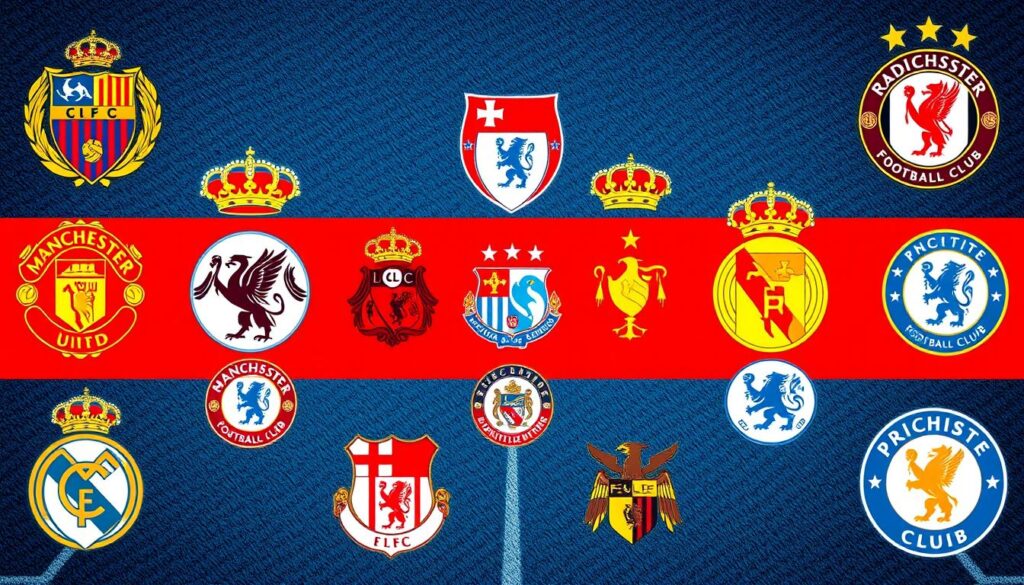
Club crests and colors are more than just looks. They represent a club’s achievements and milestones. Stars on jerseys often symbolize league titles. Juventus was the first to use this, adding a star in 1958 after winning their tenth title.
| Club | Crest | Colors | Significance |
|---|---|---|---|
| Liverpool | Liver bird and maritime symbols | Red and white | Represents the city’s status as a successful port |
| Manchester United | Red Devils nickname | Red and white | References the city’s coat of arms and incorporates the Red Devils nickname |
| Aston Villa | Rampant Lion | Claret and blue | Reflects the club’s historical significance and ties to Scottish founders |
Historic Grounds and Venues of the First Clubs
Many of the first football clubs played on iconic playing fields. These fields have been kept as historical sites. They show the sport’s rich history, with some dating back to the 19th century.
The venues where these early clubs played are key to football’s heritage. Places like Bramall Lane and Deepdale are used today. They are a big part of the sport’s history.
Here are some examples of historic grounds and venues:
- Bramall Lane, established in 1855
- Deepdale, established in 1878
- Anfield, established in 1884
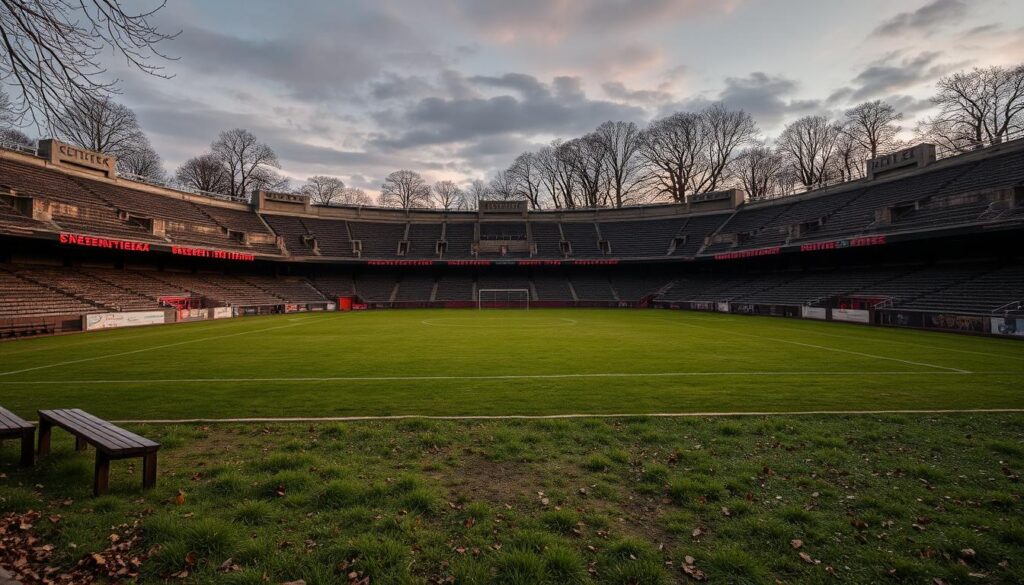
These iconic playing fields have shaped the sport into what it is today. By keeping these historic grounds and venues alive, we remember football’s history.
| Ground | Established | Current Capacity |
|---|---|---|
| Bramall Lane | 1855 | 32,702 |
| Deepdale | 1878 | 23,404 |
| Anfield | 1884 | 61,276 |
Evolution of Playing Styles Among Early Teams
The way teams played soccer changed slowly over time. This change was due to many things like rules, tactics, and how good players were. As soccer spread, different areas developed their own ways of playing, influenced by local culture and traditions.
For example, the combination game focused on teamwork and passing. On the other hand, the kick-and-rush style highlighted individual skill and speed. These styles were known for their unique formations, like the 2-3-5 formation from the late 19th century.
Here are some key moments in the evolution of playing styles:
- The offside rule was introduced in 1866. This led to more tactical and strategic play.
- The W-M formation came in the early 20th century. It focused on defense and quick counter-attacks.
- In the 1950s and 1960s, South American football influenced European teams. It brought a more fluid and attacking style.

The early teams’ playing styles have shaped soccer into what it is today. Knowing how these styles evolved helps us see the game’s complexity and diversity. It shows how soccer has grown and changed over time.
| Year | Playing Style | Characteristics |
|---|---|---|
| 1860s | Combination game | Emphasized teamwork and passing |
| 1880s | Kick-and-rush | Focused on individual skill and speed |
| 1920s | W-M formation | Emphasized defensive solidity and counter-attacking |
Impact on Modern Football Culture
Modern football culture owes a lot to the oldest football clubs. Their efforts to keep traditional values and preserve heritage are key. Keeping the sport’s history alive is vital, and many clubs are dedicated to this.
Today, values like fair play, respect, and sportsmanship are cherished. The oldest clubs have shaped the sport, from rules to gameplay. Their work in preserving history has also helped football grow.
Some clubs are doing great work to keep football’s history alive. For example:
- Promoting historical matches and tournaments
- Creating museums and exhibitions to showcase football history
- Developing educational programs to teach about the history of football
These efforts help keep football’s traditional values alive. The oldest clubs’ influence is clear in modern football. Their legacy continues to shape the sport today.

| Club | Year Founded | Heritage Preservation Efforts |
|---|---|---|
| Sheffield FC | 1857 | Promoting historical matches and tournaments |
| Cambridge University AFC | 1856 | Creating museums and exhibitions to showcase football history |
| Hallam FC | 1860 | Developing educational programs to teach about the history of football |
Legendary Players from Historic Clubs
Many legendary players have come from historic clubs. They have made a big impact on football. Lionel Messi, for example, scored 91 goals in 2012, a record. Just Fontaine also made history by scoring the most goals in a FIFA World Cup.
Other legendary players from historic clubs include Pelé and Michel Platini. Pelé won the FIFA World Cup three times. Michel Platini set a record for most goals in a UEFA European Championship. These players have not only won big but also inspired others.

Some of the most notable legendary players from historic clubs include:
- Lionel Messi
- Just Fontaine
- Pelé
- Michel Platini
These players have achieved great success. They have helped shape football into what it is today.
Celebrating Ancient Rivalries and Traditions
Football clubs have a rich history, filled with ancient rivalries that last for decades. These rivalries are fueled by traditionsand a strong desire to beat their opponents. A prime example is the rivalry between Sport Lisboa e Benfica and Sporting Clube de Portugal.
These historic derby matches have been happening for over a century. The first match between the two teams was in 1907. They have faced each other over 300 times in official games, making their rivalry one of the longest in football history.
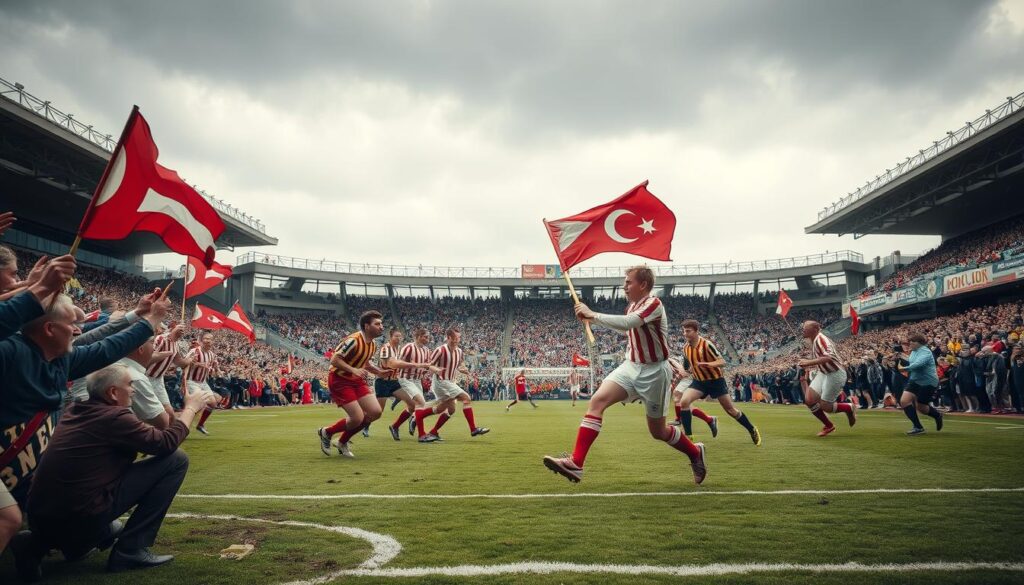
- Benfica has won a record 38 Primeira Liga titles.
- Sporting has won 19 Primeira Liga titles.
- Benfica has secured 26 Taça de Portugal victories, while Sporting has achieved 17 Taça de Portugal wins.
These ancient rivalries and traditions show the deep history of football and the passion of its fans. They continue to influence the sport and its culture. This makes historic derby matches exciting for fans all over the world.
| Team | Primeira Liga Titles | Taça de Portugal Wins |
|---|---|---|
| Benfica | 38 | 26 |
| Sporting | 19 | 17 |
Conclusion: The Enduring Legacy of Football’s Pioneers
The history of the world’s oldest football clubs is rich and deep. Their legacy shapes the sport we love today. From Sheffield FC’s innovations to Cambridge University AFC’s academic roots, these football pioneers set the stage for the game’s growth.
The enduring legacy of these clubs goes beyond just their long history. They’ve deeply influenced football’s culture, values, and traditions. Their rivalries, iconic grounds, and legendary players have made the sport appealing for years, inspiring fans and players.
Looking ahead, it’s key to keep the heritage of these pioneers alive. By honoring their legacy, we ensure the game’s spirit continues to inspire. This will help football remain the world’s most beloved sport for generations to come.
FAQ
What is the significance of the oldest football clubs in the world?
The oldest football clubs have shaped the sport’s history. They helped create the rules and styles we see today. Their legacy continues to influence the game.
When and where did the first organized football clubs emerge?
The first clubs started in the early 19th century in British public schools. These schools helped turn folk games into a structured sport. They set the early rules and regulations.
What is the history of Sheffield FC, the world’s first football club?
Sheffield FC, founded in 1857, is the oldest club. It played a key role in the sport’s early days. Its history is widely recognized.
How did the timeline of historic football clubs evolve?
The history of football clubs shows the sport’s growth. It started with early organizations, then a boom in the 1850s. Regional clubs also shaped the game’s early years.
What is the significance of Cambridge University AFC in the history of football?
Cambridge University AFC, founded in 1863, played a big role in football’s academic roots. Its history shows how education shaped the sport’s early days.
What is the significance of Hallam FC, the second oldest club to play?
Hallam FC, founded in 1860, is the second oldest club. It has a strong local derby legacy. Its efforts to keep football’s heritage alive are significant.
Where can I find a complete list of the oldest football clubs in the world?
This article lists the oldest football clubs globally. It includes British pioneers, European first clubs, and the sport’s global spread. The list highlights key clubs and their significance.
What is the significance of club crests and colors in the history of football?
Club crests and colors are vital to a team’s identity. They reflect the sport’s history and traditions. These symbols are a big part of football culture and fan experiences.
What are some of the historic grounds and venues associated with the first football clubs?
The first clubs’ grounds are historically important. They were the early playing fields that saw the sport grow. These sites are key to football’s heritage.
How have the playing styles of early football teams evolved over time?
Early teams’ playing styles changed due to rule developments, new tactics, and player influence. These styles have shaped the sport’s history and inspire today’s football.
How have the oldest football clubs impacted modern football culture?
The oldest clubs have deeply influenced modern football. They’ve kept traditional values alive. Their efforts ensure football’s pioneers continue to inspire today’s game.
Who are some of the legendary players that have come from historic football clubs?
Many legendary players started with the oldest clubs. Their careers have shaped football’s history. These players have left a lasting impact on the game.
What are some of the ancient rivalries and traditions associated with historic football clubs?
The oldest clubs have created rich rivalries and traditions. These include derby matches and ceremonies. They reflect the deep passions and loyalties in football’s history.